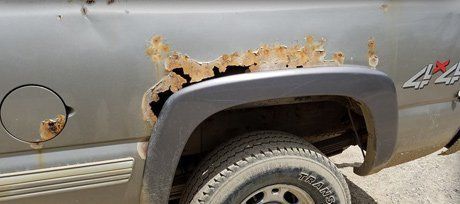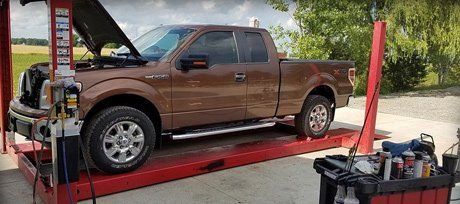Supporting copy for the Request Service
call out button.
Benefits & Facts
Call Today to Schedule an Appointment!
855-566-7878
Call Today to Schedule an Appointment!
Annual Application Will Keep Rust Away!
Some Benefits and Facts About Our Service
What Really Causes Your Vehicle to Rust?
Moisture mainly causes your vehicle to rust. This moisture combined with road salt, mud, or air pollutants in contact with your vehicle's steel provides ideal conditions for rust to occur.

Will Certain Areas of My Vehicle Corrode Faster Than Others?
Your vehicle will corrode first in the areas where moisture is allowed to sit and collect rather than drain or evaporate. These areas include seams, crevices, welds, or pockets where road dirt and salt accumulate and hold the moisture against the steel.

Can Vehicle Manufacturers Solve the Rust Problem?
Manufacturers have made many improvements since the early ‘80s by using galvanized steel, better paint, and by improving drainage and ventilation. But, in the Northeast United States (the Rust Belt) unless they discontinue the use of steel, rust will happen—it's only a question of time.
What if My Car Already Has Rust?
If the corrosion is not bad enough to require bodywork, rust inhibitor, which is sprayed under pressure will penetrate the existing corrosion and control further oxidation — significantly reducing further spreading of corrosion.
Should My Vehicle Be Washed and Cleaned Before I Can Have it Treated?
Yes and no. The product will penetrate light road dirt and effectively treat the metal on your vehicle. However, if the vehicle is packed with mud and other debris, it should be washed prior to being serviced.
If our service technicians spot small areas of excessive dirt, they will power wash them prior to application. But, if the vehicle is too dirty, they will not be able to treat it.
Will the Product Remove Existing Rust?
Rust inhibitor is designed to penetrate to the good metal and set up a barrier to repel moisture and contaminants.
How is it Applied?
It's atomized under high pressure which pushes the product deep into the seams, cracks, and crevices where corrosion starts.
Once applied, the product removes the moisture in these areas and provides a strong adherence to these surfaces, remaining active with excellent "creeping" and self-healing abilities.
How is Oil Undercoating Different Than Traditional Undercoating?
While an undercoating does provide protection to your vehicle's undercarriage, the protection stops there. And when undercoating chips, it leaves an area where road salts can penetrate and be trapped resulting in a higher potential of corrosion.
Oil undercoating provides protection to your whole vehicle and it cannot be chipped or cracked. Oil undercoating creeps and crawls into seams, cracks, and crevices where corrosion begins, and provides an active barrier between the metal and the causes of corrosion.
Do You Have to Reapply Every Year?
Yes. Just as we perform annual maintenance on our vehicle, and change the oil to maintain its effectiveness.
Rust inhibitor needs to be reapplied annually to maintain its effectiveness. When you bring your vehicle to us each year, you will receive a complete reapplication of our oil undercoating rust inhibitor as if your vehicle is being serviced for the first time. Annual service is not a "touch-up" or an inspection.
Does the Application Have to Be Done on a Dry Day?
No. The rust inhibitor has the ability to penetrate moisture effectively on metal and provide an insulating barrier.
What is the Process?
Oil undercoating is applied to your vehicle in all of the following areas:
- Engine compartment: all seams, crevices, battery mounts, hood, and latches
- Doors: all seams, boxed sections of your doors
- Exposed electrical connections of your wiring harness
- Rocker panels, fender wells, and interior sections of both
- Gas cover, all exterior metal trim, and problem areas
- Trunks, tail gates: all seams, crevices, latches, and boxed sections
- Undercarriage: the entire undercarriage is treated; care is taken to avoid brakes, belts, and exhaust.
Do You Drill Holes in the Car?
Only when necessary to access the inner compartments such as doors, rocker panels, window post area, etc. If we can access without drilling, we use existing holes provided by the manufacturer. It is essential to get into the inner compartments because that is where corrosion starts.
Will the Product Harm Electrical Wiring and Electrical Sensors?
Rust inhibitor is a petroleum-based chemical which is dialectic, and it actually insulates electrical wiring. We do avoid getting overspray on the electrical sensors during the application process.
What if My Car Is Mostly Plastic?
Plastic components have to be attached to metal clips or supports and rust inhibitor prevents corrosion in those areas, as well as the many other important parts of a vehicle.
Thumb Rust Kontrol, LLC is a Locally Owned and Operated Company!
Resell your vehicle and lower your repair bills today!
855-566-7878 (855-5-NORUST)
Our Facebook Feed
Contact Us
Thumb Rust Kontrol, LLC
1250 Elmer Road
Sandusky, MI 48471-9434
855-566-7878 (855-5-NORUST)

Privacy Policy
| Do Not Share My Information
| Conditions of Use
| Notice and Take Down Policy
| Website Accessibility Policy
© 2025
The content on this website is owned by us and our licensors. Do not copy any content (including images) without our consent.
